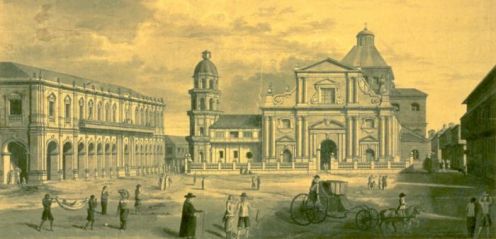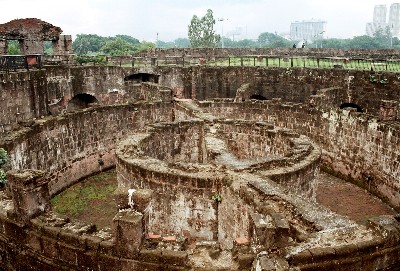
 The PLM is located in the historic vicinity of Intramuros, immortalized in history as the Walled City during the three centuries of Spanish colonization and was built to become the fortress enclave of the Spanish conquistadores and later, the Spanish King's viceroys and governors-general to the Philippines appointed by the Royal Court to head this Spanish colony. It was where the now City of Manila began with a population of 250 after its foundation on 1571 June 24 as the capital of the Philippines, after which the capital city was honored by the King of Spain with a coat-of-arms and a grandiose title "Insigne y Siempre Leal Ciudad" or "Distinguished and Ever Faithful" or "Noble and Ever Loyal," about a month after the sovereignty of Spain was installed on 1571 May 18 by Don Miguel Lopez de Legazpi, a Spanish conquistador, in honor of King Philip II. He proclaimed Manila as the capital of the Spanish East Indies in 1571 and the permanent seat of the Spanish colonial government in the western Pacific Ocean.
The PLM is located in the historic vicinity of Intramuros, immortalized in history as the Walled City during the three centuries of Spanish colonization and was built to become the fortress enclave of the Spanish conquistadores and later, the Spanish King's viceroys and governors-general to the Philippines appointed by the Royal Court to head this Spanish colony. It was where the now City of Manila began with a population of 250 after its foundation on 1571 June 24 as the capital of the Philippines, after which the capital city was honored by the King of Spain with a coat-of-arms and a grandiose title "Insigne y Siempre Leal Ciudad" or "Distinguished and Ever Faithful" or "Noble and Ever Loyal," about a month after the sovereignty of Spain was installed on 1571 May 18 by Don Miguel Lopez de Legazpi, a Spanish conquistador, in honor of King Philip II. He proclaimed Manila as the capital of the Spanish East Indies in 1571 and the permanent seat of the Spanish colonial government in the western Pacific Ocean.
 During the three centuries of Spanish colonialism, Intramuros served as the seat of power, both of the government and the clergy. As the seat of the Church and the State, Intramuros was a witness to the famous annual Galleon Trade with Acapulco in Mexico, having been located along the long stretch of the ever-famous Manila Bay, one of the world's finest and best natural harbors. Manila was then developed to be a major port to pave a way for an intensified trade and commerce activities and massive industrialization of the pueblos around it.
During the three centuries of Spanish colonialism, Intramuros served as the seat of power, both of the government and the clergy. As the seat of the Church and the State, Intramuros was a witness to the famous annual Galleon Trade with Acapulco in Mexico, having been located along the long stretch of the ever-famous Manila Bay, one of the world's finest and best natural harbors. Manila was then developed to be a major port to pave a way for an intensified trade and commerce activities and massive industrialization of the pueblos around it.
 Intramuros was shaped like a pentagon with a perimeter of 4 kilometers long, located along the delta of land at the mouth of the Pasig River, along its southern bank, which through hundreds of years has evolved into a foreshore as it used to be a part of the sea which reached as far as the present city of Mandaluyong ("a place of waves") and Makati ("a place of tides").
Intramuros was shaped like a pentagon with a perimeter of 4 kilometers long, located along the delta of land at the mouth of the Pasig River, along its southern bank, which through hundreds of years has evolved into a foreshore as it used to be a part of the sea which reached as far as the present city of Mandaluyong ("a place of waves") and Makati ("a place of tides").
Today, substantial sections of the encircling wall, which was begun in 1590 and restored in 1970s, remain, including a number of decorated gates, one of which leads to the campus of PLM.
